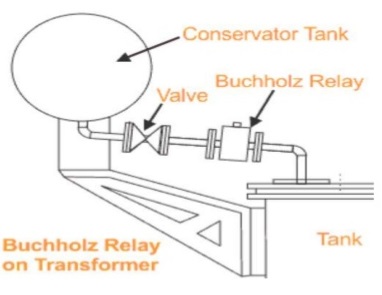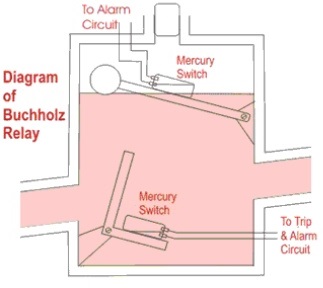Buchholz Relay Circuit is used for Transformer Protection, as we know there are many defects and dangers during the operation of power transformer that need to be addressed and necessary measures to be taken. Some of the hazards to transformer protection include overheating, over current and short circuiting etc. Another class of fault that causes a transformer problems is incipient faults which are not serious at the beginning but which slowly develop into serious faults causing a transformer to malfunction.
Buchholz Relay is mainly a gas relay used in transformers for overcoming the dangerous and slow mechanical phenomenon generating gas bubbles. This is to be noted that there are always minor internal faults happening in the transformer such as an insulation faults between turns, break down of core of transformer, core heating etc. due to these faults transformer insulating oil will be decomposed in different hydrocarbon gases, CO2 and CO which accumulate inside the body of transformer. The Buchholz relay gives an alarm when a specified amount of gas is formed. The analysis of the gas collected in the relay chamber indicates the type of the incipient fault which further can be used for analyzing the transformer faults.
Buchholz pressure type gas relays are connected between the tank and the conservator (in the piping) of transformer. One of the 2 elements of this relay is a gas-collecting chamber. After a certain amount of gas is collected, a contact is closed to sound an alarm. The second element contains a vane that is operated by the rush of oil through the piping. The first is used to protect against slow breakdown of insulation while the second against severe faults occurring inside the transformer.

Principle of Buchholz Relay
When a fault develops slowly inside a transformer it produces heat which inserts decomposing effects on solid or liquid insulating materials inside the transformer. The slow process of decomposition of insulating materials produces inflammable gases. Buchholz relay is placed inside a small tank between the transformer tank and the conservator. The Buchholz relay is a slow acting device with minimum operating time of 0.1 second and the average time of 0.2 second.
When an incipient fault such as a winding-to-core fault or an inter-turn fault occurs on the transformer winding, there is severe heating of the oil. This causes gases to be liberated from the hot oil that heats up to around 350°C. Due to high temperature build-up of oil pressure causes oil to rush into the conservator. A vane is placed in the path of surge of oil between the transformer and the conservator. A set of contacts, operated by this vane, is used as trip contacts of the Buchholz relay This output of Buchholz relay may be used to trip the transformer.
The Buchholz relay also has another set of contacts operated by a float. These contacts stay open when the transformer tank is filled with oil. However, in case of leakage of oil or decomposition of oil, the float sinks causing the contacts to close. Loss of oil will no doubt cause the transformer temperature to rise but does not warrant immediate tripping. Hence, normally these contacts are wired to an alarm which alerts the operator via activating the fault alarm.
Operation of Buchholz Relay for Transformer Protection
The gases produced due to decomposition of transformer insulating oil will accumulate in the upper part the Buchholz container which causes fall of oil level in it. It is mechanically actuated. Fall of oil level means lowering the position of float and thereby tilting the mercury switch. The contacts of this mercury switch are closed and an alarm circuit energized. Sometime due to oil leakage on the main tank air bubbles may be accumulated in the upper part the Buchholz container which may also cause fall of oil level in it and alarm circuit will be energized. The signal from the buchholz relay can be used for isolating the transformer from main circuit by activating the relevant circuit breakers hence protecting the electrical wiring system from further damages.

Construction of Buchholz Relay
Buchholz relays designed for transformer protection consist of mainly two elements:
- The upper element consists of a float. The float is attached to a hinge in such a way that it can move up and down depending upon the oil level in the Buchholz relay Container. One mercury switch is fixed on the float. The alignment of mercury switch hence depends upon the position of the float.
- The lower element consists of a baffle plate and mercury switch. This plate is fitted on a hinge just in front of the inlet (main tank side) of Buchholz relay in transformer in such a way that when oil enters in the relay from that inlet in high pressure the alignment of the baffle plate along with the mercury switch attached to it will change. In addition to these main elements a Buchholz relay has gas release pockets on top. The electrical leads from both mercury switches are taken out through a molded terminal block from the body of transformer.
Discover more from Electrical Engineering 123
Subscribe to get the latest posts sent to your email.
